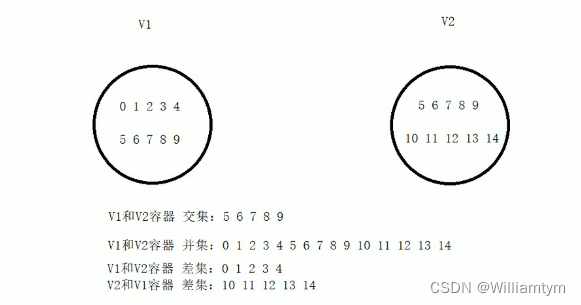值得记忆的STL常用算法,分分钟摆脱容器调用的困境,以vector为例,其余容器写法类似
STL常用算法
概述:
-
算法主要是由头文件
<algorithm><functional><numeric>组成 -
<algorithm>是所有STL头文件中最大的一个,范围涉及到比较、交换、查找、遍历操作、复制、修改等等 -
<nuneric>体积很小,只包括几个在序列上面进行简单数学运算的模板函数 -
<functional>定义了一些模板类,用以声明函数对象
1.常用遍历算法
算法简介:
for_each遍历容器
transform搬运容器到另一个容器
1.for_each
功能描述:
实现遍历容器
函数原型:
for_each(iterator beg, iterator end, _func);
遍历算法 遍历容器中所有元素
beg开始迭代器
end结束迭代器
_func函数或者函数对象
示例
#include<iostream>
#include<vector>
#include<algorithm>
using namespace std;
//常用遍历算法 for_each
//普通函数
void print01(int val)
{
cout << val << " ";
}
//仿函数
class print02
{
public:
void operator()(int val)
{
cout << val << " ";
}
};
void test()
{
vector<int>v;
for(int i = 0;i < 10; i++)
{
v.push_back(i);
}
for_each(v.begin(), v.end(), print01);
cout << endl;
for_each(v.begin(), v.end(), print02());
cout << endl;
}
int main()
{
test();
return 0;
}总结:for_each在实实际开发中是最常用遍历算法,需要熟练掌握
2.transform
功能描述:
搬运容器到另一个容器中
函数原型:
tansform(iterator beg1, iterator end1, iterator beg2, _func);
beg1源容器开始迭代器
end1源容器结束迭代器
beg2目标容器开始迭代器
_func函数或者函数对象
示例:
#include<iostream>
#include<vector>
#include<algorithm>
using namespace std;
//常用遍历算法 transform
class Transform
{
public:
int operator()(int v)
{
return v;
}
};
class print
{
public:
int operator()(int val)
{
cout << val << " ";
}
};
void test()
{
vector<int>v;
for(int i = 0;i < 10; i++)
{
v.push_back(i);
}
vector<int>vTarget;//目标容器
vTarget.resize(v.size());//目标容器需要提前开辟空间
transform(v.begin(), v.end(), vTarget.begin(), Transform());
for_each(v.begin(), v.end(), print());
}
int main()
{
test();
return 0;
}2.常用查找算法
算法简介:
find查找元素
find_if按条件查找
adjacent_find查找相邻重复元素
binary_search二分查找
count统计元素个数
count_if按条件统计元素个数
1.find
功能描述:
查找指定元素,找到返回指定元素的迭代器,找不到返回结束迭代器end()
函数原型:
find(iterator beg, iterator end, value);
按值查找元素,找到返回指定位置迭代器,找不到返回结束迭代器位置
beg开始迭代器
end结束迭代器
value查找的元素
代码
#include<iostream>
#include<vector>
#include<algorithm>
#include<string>
using namespace std;
//常用的查找算法
//find
//查找 内指数据类型
void test01()
{
vector<int>v;
for(int i = 0;i < 10; i++)
{
v.push_back(i);
}
//查找 容器中 是否有 5 这个元素
vector<int>::iterator it = find(v.begin(), v.end(), 5);
if(it == v.end())
{
cout << "没有找到!" << endl;
}
else
{
cout << "找到了!" << *it << endl;
}
}
//查找 自定义数据类型
class Person
{
public:
Person(string name, int age)
{
this->m_Name = name;
this->m_Age = age;
}
//重载 == 使底层find知道如何对比person数据类型
bool operator==(const Person & p)
{
if(this->m_Name == p.m_Name && this->m_Age == p.m_Age)
{
return true;
}
else
{
return false;
}
}
string m_Name;
int m_Age;
};
void test02()
{
vector<Person>v;
//创建数据
Person p1("zhangsan",18);
Person p2("lisi",19);
Person p3("wangwu",20);
Person p4("zaholiu",21);
Person p5("tangqi",22);
//放入容器
v.push_back(p1);
v.push_back(p2);
v.push_back(p3);
v.push_back(p4);
v.push_back(p5);
Person p("wangwu",20);
vector<Person>::iterator it = find(v.begin(), v.end(), p);
if(it == v.end())
{
cout << "没有找到!" << endl;
}
else
{
cout << "找到了:" << "姓名为:" << it->m_Name << " 年龄为:" << it->m_Age << endl;
}
}
int main()
{
test01();
test02();
return 0;
}2.find_if
功能描述:
按条件查找元素
函数原型:
find_if(iterator beg, iterator end, _Pred);
按值查找元素,找到返回指定位置迭代器,找不到返回结束迭代器位置
beg开始迭代器
end结束迭代器
_Pred函数或者谓词(返回bool类型的仿函数)
示例:
#include<iostream>
#include<vector>
#include<string>
#include<algorithm>
using namespace std;
//常用查找算法 find_if
//1.查找内置数据类型
class GreaterFive
{
public:
bool operator()(int val)
{
return val > 5;
}
};
void test01()
{
vector<int>v;
for(int i = 0;i < 10; i++)
{
v.push_back(i);
}
vector<int>::iterator it = find_if(v.begin(), v.end(), GreaterFive());
if(it == v.end())
{
cout << "没有找到" << endl;
}
else
{
cout << "找到大于5的数字:" << *it << endl;
}
}
//2.查找自定义数据类型
class Person
{
public:
Person(string name, int age)
{
this->m_Name = name;
this->m_Age = age;
}
string m_Name;
int m_Age;
};
class GreaterT
{
public:
bool operator()(Person &p)
{
return p.m_Age > 20;
}
};
void test02()
{
vector<Person>v;
Person p1("zhangsan",19);
Person p2("lisi",20);
Person p3("wangwu",21);
Person p4("zhaoliu",22);
v.push_back(p1);
v.push_back(p2);
v.push_back(p3);
v.push_back(p4);
//找年龄大于20岁的
vector<Person>::iterator it = find_if(v.begin(), v.end(), GreaterT());
if(it == v.end())
{
cout << "没有找到" << endl;
}
else
{
cout << "找到了姓名:" << it->m_Name << " 年龄:" << it->m_Age << endl;
}
}
int main()
{
test01();
test02();
return 0;
}3.adjacent_find
功能描述:
查找相邻重复元素
函数原型:
adjacent_find(iterator beg,iterator end);
查找相邻里复元素返回相邻元素的第一个位置的迭代器
beg开始迭代器
end结束迭代器
示例:
#include<iostream>
#include<vector>
#include<algorithm>
using namespace std;
//常用查找算法 adjacent_find
void test()
{
vector<int>v;
v.push_back(0);
v.push_back(2);
v.push_back(0);
v.push_back(3);
v.push_back(1);
v.push_back(4);
v.push_back(3);
v.push_back(3);
vector<int>::iterator pos = adjacent_find(v.begin(), v.end());
if(pos == v.end())
{
cout << "未找到相邻重复元素" << endl;
}
else
{
cout << "找到相邻重复元素:" << *pos << endl;
}
}
int main()
{
test();
return 0;
}4.binary_search
功能描述:
查找指定元素是否存在
函数原型:
bool binary_search(iterator beg,iterator end,value);
查找指定的元素,查到返回true否则false
注意:在无序序列中不可用
beg开始迭代器
end结束迭代器
value查找的元素
示例:
#include<iostream>
#include<vector>
#include<algorithm>
//常用查找算法 binary_search
void test()
{
vector<int>v;
for(int i = 0;i < 10; i++)
{
v.push_back(i);
}
//查找容器中是否有9 元素
bool ret = binary_search(v.begin(), v.end(), 9);
if(ret)
{
cout << "找到了元素" << endl;
}
else
{
cout << "没有找到" << endl;
}
}
int main()
{
test();
return 0;
}总结:二分查找法查找效率很高,值得注意的是查找的容器中元素必须得是有序序列
5.count
功能描述:
统计元素个数
函数原型:
count(iterator beg,iterator end,value);
统计元素出现次数
beg开始迭代器
end结束迭代器
value统计的元素
示例:
#include<iostream>
#include<string>
#include<vector>
#include<algorithm>
using namespace std;
//常用查找算法 count
//1.统计内置数据类型
void test1()
{
vector<int>v;
v.push_back(1);
v.push_back(2);
v.push_back(3);
v.push_back(3);
v.push_back(3);
v.push_back(4);
int num = count(v.begin(), v.end(), 3);
cout << "3的元素个数:" << num << endl;
}
//2.统计自定义数据类型
class Person
{
public:
Person(string name, int age)
{
this->m_Name = name;
this->m_Age = age;
}
bool operator==(const Person& p)
{
if(this->m_Age == p.m_Age)
{
return true;
}
else
{
return false;
}
}
string m_Name;
int m_Age;
};
void test2()
{
vector<Person>v;
Person p1("aaa",18);
Person p2("bbb",19);
Person p3("ccc",20);
Person p4("ddd",18);
Person p5("eee",18);
Person p6("fff",18);
v.push_back(p1);
v.push_back(p2);
v.push_back(p3);
v.push_back(p4);
v.push_back(p5);
v.push_back(p6);
Person p7("ggg",18);
int num = count(v.begin(), v.end(), p7);
cout << "和p7年龄一样的有" << num << "个" << endl;
}
int main()
{
test1();
test2();
return 0;
}6.count_if
功能描述:
按条件统计元素个数
函数原型:
count_if(iterator beg, iterator end, _Pred);
按条件统计元素出现次数
beg开始迭代器
end结束迭代器
_Pred谓词
示例:
#include<iostream>
#include<vector>
#include<string>
#include<algorithm>
using namespace std;
//1.内置数据类型统计
class Greater20
{
public:
bool operator()(int val)
{
return val > 20;
}
};
void test()
{
vector<int>v;
v.push_back(10);
v.push_back(40);
v.push_back(30);
v.push_back(20);
int num = count_if(v.begin(), v.end(), Greater20());
cout << "大于20的元素个数为:" << num << endl;
}
//2.自定义的数据类型
class Person
{
public:
Person(string name, int age)
{
this->m_Name = name;
this->m_Age = age;
}
bool operator==(const Person&p)
{
if(this->m_Age == p.m_Age)
{
return true;
}
else
{
return false;
}
}
string m_Name;
int m_Age;
};
class AgeGreater18
{
public:
bool operator()(const Person & p)
{
return p.m_Age == 18;
}
};
void test1()
{
vector<Person>v;
Person p1("zhangsan",18);
Person p2("lisi",18);
Person p3("wangwu",19);
Person p4("zhaoliu",18);
v.push_back(p1);
v.push_back(p2);
v.push_back(p3);
v.push_back(p4);
int num = count_if(v.begin(), v.end(), AgeGreater18());
cout << "18岁的人数:" << num << "个" << endl;
}
int main()
{
test();
test1();
return 0;
}3.常用排序算法
算法简介:
sort对容器内元素进行排序
random_shuffle洗牌 指定范围内的元素随机调整次序
merge容器元素合并,并存储到另一容器中
reverse反转指定范围的元素
1.sort
功能描述:
对容器内元素进行排序
函数原型:
sort(iterator beg,iterator end,Pred);按值查找元素,找到返回指定位置迭代器,找不到返回结束迭代器位置
beg开始迭代器
end结束迭代器
_Pred谓词
示例
#include<iostream>
#include<vector>
#include<algorithm>
#include<functional>
using namespace std;
class print
{
public:
operator()(int val)
{
cout << val << " ";
}
};
void test()
{
vector<int>v;
v.push_back(10);
v.push_back(30);
v.push_back(50);
v.push_back(20);
v.push_back(40);
//利用sort进行升序
sort(v.begin(), v.end());
for_each(v.begin(), v.end(), print());
cout << endl;
//改为降序
sort(v.begin(), v.end(), greater<int>());//greater内建函数
for_each(v.begin(), v.end(), print());
cout << endl;
}
int main()
{
test();
return 0;
}2.random_shuffle
功能描述:
洗牌指定范围内的元素随机调整次序
函数原型:
random_shuffle(iterator beg,iterator end);
指定范围内的元素随机调整次序
beg开始迭代器
end结束迭代器
示例:
#include<iostream>
#include<vector>
#include<algorithm>
#include<ctime>
using namespace std;
//常用排序算法 random_shuffle
class print
{
public:
operator()(int val)
{
cout << val << " ";
}
};
void test()
{
srand((unsigned int)time(NULL));
vector<int>v;
for(int i = 0;i < 10; i++)
{
v.push_back(i);
}
//利用洗牌算法 打乱顺序
random_shuffle(v.begin(), v.end());
for_each(v.begin(), v.end(), print());
}
int main()
{
test();
return 0;
}总结:random_shuffle洗牌算法比较实用,使用时记得加随机数种子
3.merge
功能描述:
两个容器元素合并,并存储到另一容器中
函数原型:
merge(iterator beg1,iterator end1,iterator beg2,iterator end2,iterator dest);
容器元素合并,并存储到另一容器中
注意:两个容器必须是有序的,而且两个均为升序或降序
beg1容器1开始迭代器
end1容器1结束迭代器
beg2容器2开始迭代器
end2客器2结束送代器
dest目标容器开始迭代器
示例:
#include<iostream>
#include<vector>
#include<algorithm>
using namespace std;
//常用的排序算法 merge
//仿函数
class print
{
public:
operator()(int val)
{
cout << val << " ";
}
};
void test()
{
vector<int>v1;
vector<int>v2;
for(int i = 0;i < 10; i++)
{
v1.push_back(i);
v2.push_back(i+1);
}
//目标容器
vector<int>vTarget;
vTarget.resize(v1.size() + v2.size());
merge(v1.begin(), v1.end(), v2.begin(), v2.end(), vTarget.begin());
for_each(vTarget.begin(), vTarget.end(), print());
cout << endl;
}
int main()
{
test();
return 0;
}4.reverse
功能描述:
将容器内元素进行反转
函数原型: reverse(iterator beg,iterator end);
反转指定范围的元素
beg开始迭代器
end结束迭代器
#include<iostream>
#include<vector>
#include<algorithm>
using namespace std;
//常用排序算法 reverse
class print
{
public:
operator()(int val)
{
cout << val << " ";
}
};
void test()
{
vector<int>v;
for(int i = 0;i < 10; i++)
{
v.push_back(i);
}
cout << "反转前:" << endl;
for_each(v.begin(), v.end(), print());
cout << endl;
reverse(v.begin(), v.end());
cout << "反转后:" << endl;
for_each(v.begin(), v.end(), print());
}
int main()
{
test();
return 0;
}4.常用拷贝和替换算法
算法简介:
copy容器内指定范围的元素拷贝到另一容器中
replace将容器内指定范围的旧元素修改为新元素
replace_if容器内指定范围满足条件的元素替换为新元素
swap互换两个容器的元素
1.swap
功能描述:
容器内指定范围的元素拷贝到另一容器中
函数原型:
copy(iterator beg,iterator end,iterator dest);
按值查找元素,找到返回指定位置迭代器,找不到就返回结束迭代器位置
beg开始迭代器
end结束迭代器
dest目标超始迭代器
示例:
#include<iostream>
#include<vector>
#include<algorithm>
using namespace std;
//常用拷贝和替换算法 copy
class print
{
public:
operator()(int val)
{
cout << val << " ";
}
};
void test()
{
vector<int>v1;
for(int i = 0;i < 10; i++)
{
v1.push_back(i);
}
vector<int>v2;
v2.resize(v1.size());
copy(v1.begin(), v1.end(), v2.begin());
for_each(v2.begin(), v2.end(), print());
cout << endl;
}
int main()
{
test();
return 0;
}2.replace
功能描述:
将容器内指定范围的旧元素核改为新元素
函数原型:
replace(iterator beg,iterator end, oldvalue, newvalue);
将区间内旧元素替换成新元素
beg开始迭代器
end结束迭代器
oldvalue旧元素
newvalue新元素
示例:
#include<iostream>
#include<vector>
#include<algorithm>
using namespace std;
//常用拷贝和替换算法replace
class print
{
public:
operator()(int val)
{
cout << val << " ";
}
};
void test()
{
vector<int>v;
v.push_back(20);
v.push_back(30);
v.push_back(40);
v.push_back(30);
v.push_back(40);
v.push_back(10);
v.push_back(20);
v.push_back(20);
cout << "替换前:" << endl;
for_each(v.begin(), v.end(), print());
cout << endl;
//将20替换为200
replace(v.begin(), v.end(), 20, 200);
cout << "替换后:" << endl;
for_each(v.begin(), v.end(), print());
cout << endl;
}
int main()
{
test();
return 0;
}3.replace_if
功能描述:
将区间内满足条件的元素,苔换成指定元素
函数原型:
replace_if(iterator beg,iterator end,_pred,newvalue);
按条件换元素,满足条件的替换成指定元素
beg开始迭代器
end结束迭代器
_pred谓词
newvalue替换的新元素
#include<iostream>
#include<vector>
#include<algorithm>
using namespace std;
//常用拷贝和替换算法replace_if
class print
{
public:
operator()(int val)
{
cout << val << " ";
}
};
class Greater
{
public:
bool operator()(int val)
{
return val > 30;
}
};
void test()
{
vector<int>v;
v.push_back(20);
v.push_back(30);
v.push_back(40);
v.push_back(30);
v.push_back(40);
v.push_back(10);
v.push_back(20);
v.push_back(20);
cout << "替换前:" << endl;
for_each(v.begin(), v.end(), print());
cout << endl;
//将大于30的替换为100
replace_if(v.begin(), v.end(), Greater(), 100);
cout << "替换后:" << endl;
for_each(v.begin(), v.end(), print());
cout << endl;
}
int main()
{
test();
return 0;
}总结:replace_if按条件查找,可以利用仿函数灵活筛选满足的条件
4.swap
功能描述:
互换两个容器的元素
函数原型: swap(container c1,container c2);互换两个容器的元素
c1容器1
c2容器2
示例
#include<iostream>
#include<vector>
#include<algorithm>
using namespace std;
//常用拷贝和替换算法 swap
class print
{
public:
operator()(int val)
{
cout << val << " ";
}
};
void test()
{
vector<int>v1;
vector<int>v2;
for(int i = 0;i < 10; i++)
{
v1.push_back(i);
v2.push_back(i + 100);
}
cout << "交换前:" << endl;
for_each(v1.begin(), v1.end(), print());
cout << endl;
for_each(v2.begin(), v2.end(), print());
cout << endl;
cout << "--------------------------" << endl;
cout << "交换后:" << endl;
swap(v1, v2);
for_each(v1.begin(), v1.end(), print());
cout << endl;
for_each(v2.begin(), v2.end(), print());
cout << endl;
}
int main()
{
test();
return 0;
}5.常用算法生成算法
注意:
算术生成算法属于小型算法,使用时包含的头文件为include<numeric>
算法简介: accumulate计算容器元素累计总和
fill向容器中添加元素
1.accumulate
功能描述:
计算区间内容器元素累计总和
函数原型: accumulate(iterator beg,iterator end,value);
计算容器元素累计总和
beg开始迭代器
end结束迭代器
value起始值
示例:
#include<iostream>
#include<vector>
#include<numeric>
using namespace std;
//常用算法生成算法
class print
{
public:
operator()(int val)
{
cout << val << " ";
}
};
void test()
{
vector<int>v;
for(int i = 0;i <= 100; i++)
{
v.push_back(i);
}
int total = accumulate(v.begin(), v.end(), 0);
cout << "累计求和值为:" << total << endl;
}
int main()
{
test();
return 0;
}总结:accumulate使用时头文件注意是numeric,这个算法很实用
2.fill
功能描述:
向容器中填充相定的元素
函数原型:
fill(iterator beg,iterator end,value);
向容器中填充元素
beg开始迭代器
end结束迭代器
value填充的值
示例:
#include<iostream>
#include<vector>
#include<numeric>
#include<algorithm>
using namespace std;
//常用算法生成算法
class print
{
public:
operator()(int val)
{
cout << val << " ";
}
};
void test()
{
vector<int>v;
v.resize(10);
//后期重新填充
fill(v.begin(), v.end(), 100);
for_each(v.begin(), v.end(), print());
}
int main()
{
test();
return 0;
}6.常用集合算法
算法简介:
set_intersection求两个容器的交集
set_union求两个容器的并集
set_difference求两个容器的差集

1.set_intersection
功能描述:
求两个容器的交集
函数原型:
set_intersection(iterator beg1, iterator end1, iterator beg2, iterator end2, iterator dest);求两个集合的交集
示例:
#include<iostream>
#include<vector>
#include<algorithm>
using namespace std;
//常用集合算法
class print
{
public:
operator()(int val)
{
cout << val << " ";
}
};
void test()
{
vector<int>v1;
vector<int>v2;
for(int i = 0;i < 10; i++)
{
v1.push_back(i);
v2.push_back(i + 5);
}
vector<int>vTarget;
//目标容器需要提前开辟空间
//最特殊情况就是大容器包含小容器,开辟空间取小容器的size即可
vTarget.resize(min(v1.size(), v2.size()));
//获取交集
vector<int>::iterator itEnd = set_intersection(v1.begin(), v1.end(), v2.begin(), v2.end(), vTarget.begin());
for_each(vTarget.begin(), itEnd, print());
}
int main()
{
test();
return 0;
}总结:
求交集的两个集合必须的有序序列
目标容器开辟空间需要从两个容器中取小值
set_intersection返回值既是交集中最后一个元素的位置
2.set_union
功能描述:
求两个集合的并集
函数原型:
set_union(iterator begl, iterator end1, iterator beg2, iterator end2, iterator dest);
求两个集合的并集I
注意:两个集合必须是有序序列
beg1 容器1开始迭代器
end1 容器1结束迭代器
beg2 容器2开始迭代器
end2 容器2结束迭代器
dest目标容器开始迭代器
示例:
#include<iostream>
#include<vector>
#include<algorithm>
using namespace std;
//常用集合算法
class print
{
public:
operator()(int val)
{
cout << val << " ";
}
};
void test()
{
vector<int>v1;
vector<int>v2;
for(int i = 0;i < 10; i++)
{
v1.push_back(i);
v2.push_back(i + 5);
}
vector<int>vTarget;
vTarget.resize(v1.size() + v2.size());
vector<int>::iterator itEnd = set_union(v1.begin(), v1.end(), v2.begin(), v2.end(), vTarget.begin());
for_each(vTarget.begin(), itEnd, print());
}
int main()
{
test();
return 0;
}总结:
求并集的两个集合必须的有序序列
目标容器开辟空间需要两个容器相加
set_union返回值既是并集中最后一个元素的位置
3.set_difference
功能描述:
求两个集合的差集
函数原型:
set_difference(iterator beg1,iterator end1,iterator beg2,iterator end2,iterator dest);
求两个集合的差集
注意:两个集合必须是有序序列
beg1容器1开始迭代器
end1容器1结束迭代器
beg2容器2开始迭代器
end2容器2结束迭代器
dest目标容器开始迭代器
#include<iostream>
#include<vector>
#include<algorithm>
using namespace std;
//常用集合算法
class print
{
public:
operator()(int val)
{
cout << val << " ";
}
};
void test()
{
vector<int>v1;
vector<int>v2;
for(int i = 0;i < 10; i++)
{
v1.push_back(i);
v2.push_back(i + 5);
}
vector<int>vTarget;
vTarget.resize(max(v1.size(),v2.size()));
vector<int>::iterator itEnd = set_difference(v1.begin(), v1.end(), v2.begin(), v2.end(), vTarget.begin());
cout << "v1和v2的差集:" << endl;
for_each(vTarget.begin(), itEnd, print());
cout << endl;
itEnd = set_difference(v2.begin(), v2.end(), v1.begin(), v1.end(), vTarget.begin());
cout << "v2和v1的差集:" << endl;
for_each(vTarget.begin(), itEnd, print());
cout << endl;
}
int main()
{
test();
return 0;
}
